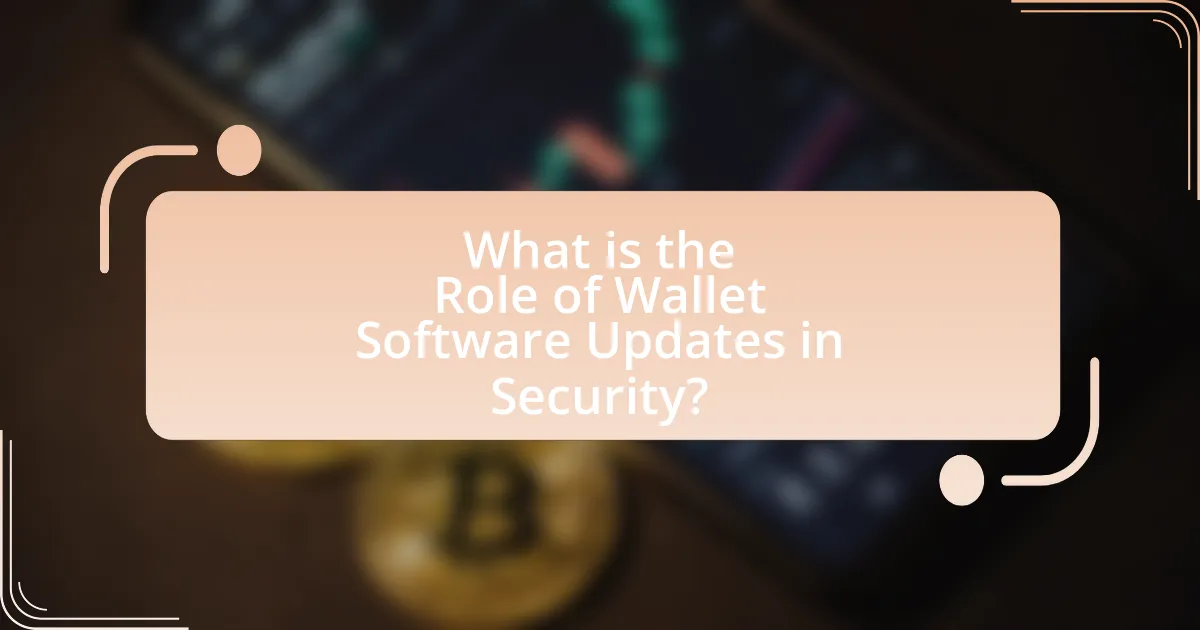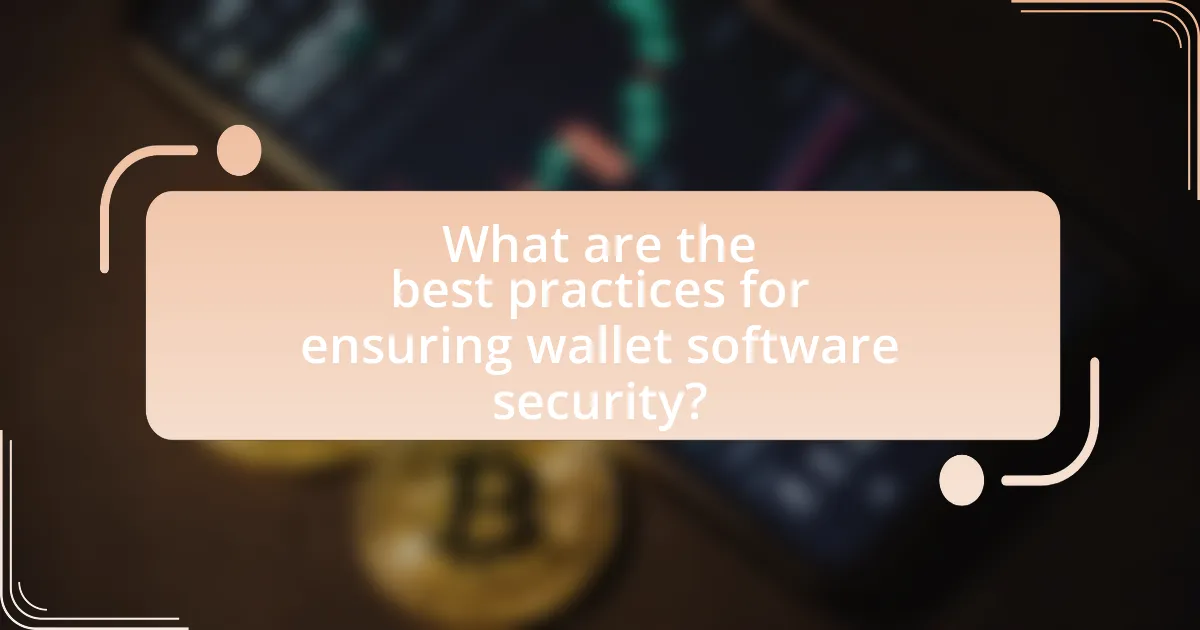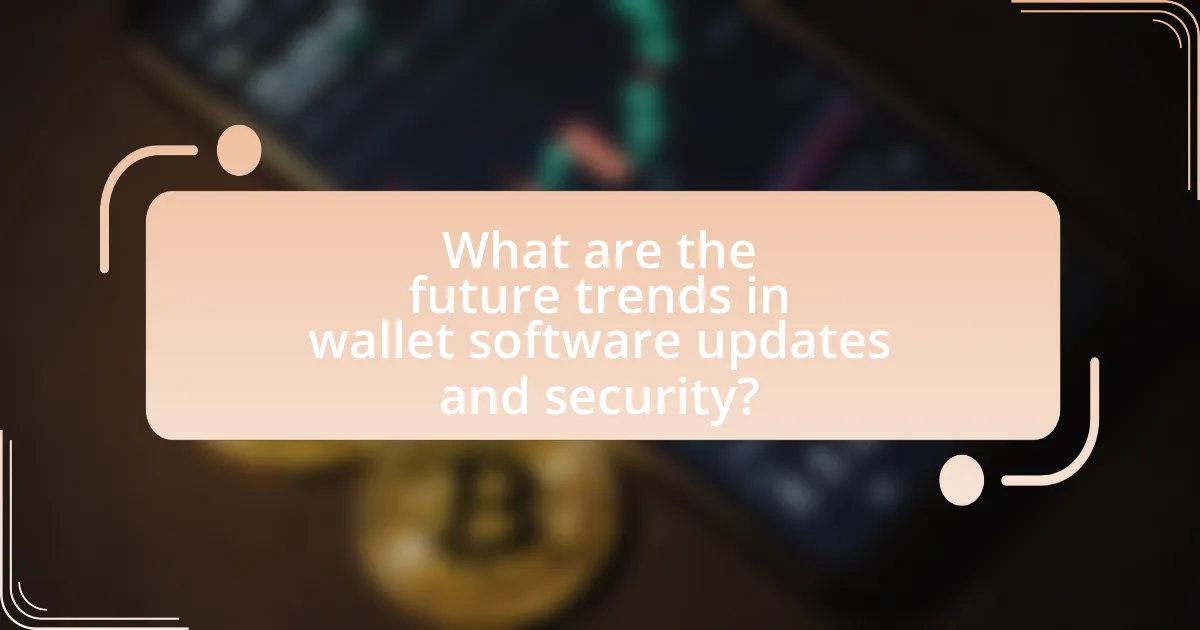Wallet software updates are essential for maintaining security in digital transactions by addressing vulnerabilities and introducing new protective features. Regular updates significantly reduce the risk of unauthorized access and financial loss by patching known exploits and enhancing encryption protocols. The article explores the types of vulnerabilities that updates address, the importance of timely updates in safeguarding against emerging threats, and best practices for users to manage their wallet software effectively. Additionally, it discusses the role of user education in wallet security and highlights future trends in wallet software updates and security technologies.

What is the Role of Wallet Software Updates in Security?
Wallet software updates play a crucial role in enhancing security by addressing vulnerabilities and introducing new security features. Regular updates ensure that the wallet software is equipped to defend against emerging threats, such as malware and hacking attempts. For instance, a study by the Cybersecurity & Infrastructure Security Agency (CISA) highlights that outdated software is a primary target for cybercriminals, as they exploit known vulnerabilities. By implementing updates, wallet software developers can patch these vulnerabilities, thereby reducing the risk of unauthorized access and financial loss. Additionally, updates often include improvements in encryption protocols, which further safeguard user data and transactions.
How do wallet software updates enhance security measures?
Wallet software updates enhance security measures by patching vulnerabilities and introducing new security features. These updates often address known exploits that could be leveraged by attackers, thereby reducing the risk of unauthorized access to user funds. For instance, a study by the Cybersecurity & Infrastructure Security Agency (CISA) highlights that timely software updates can mitigate up to 85% of known vulnerabilities. Additionally, updates may include advanced encryption protocols and multi-factor authentication options, further strengthening the overall security framework of the wallet.
What types of vulnerabilities do updates address?
Updates address various types of vulnerabilities, including security flaws, bugs, and performance issues. Specifically, they often target vulnerabilities such as software bugs that can be exploited by attackers, security loopholes that may allow unauthorized access, and compatibility issues that can affect the overall functionality of the wallet software. For instance, a report by the Cybersecurity and Infrastructure Security Agency (CISA) highlights that timely updates can mitigate risks associated with known vulnerabilities, thereby enhancing the security posture of wallet software.
How do updates protect against emerging threats?
Updates protect against emerging threats by providing essential security patches and enhancements that address newly discovered vulnerabilities. These updates are crucial as they often contain fixes for exploits that cybercriminals may leverage to compromise systems. For instance, in 2020, the Microsoft Patch Tuesday updates addressed over 100 vulnerabilities, including critical flaws that could allow remote code execution. By regularly applying updates, users ensure that their software is fortified against the latest threats, thereby reducing the risk of data breaches and unauthorized access.
Why are regular updates crucial for wallet security?
Regular updates are crucial for wallet security because they address vulnerabilities and enhance protection against emerging threats. Wallet software is often targeted by cybercriminals who exploit outdated systems; for instance, a study by the Cybersecurity & Infrastructure Security Agency found that 60% of breaches involved unpatched vulnerabilities. By implementing updates, wallet providers can fix security flaws, improve encryption methods, and ensure compliance with the latest security standards, thereby significantly reducing the risk of unauthorized access and financial loss.
What risks are associated with outdated wallet software?
Outdated wallet software poses significant security risks, including vulnerability to cyberattacks, loss of funds, and exposure of sensitive information. When wallet software is not updated, it lacks the latest security patches that protect against known exploits. For instance, a study by the Cybersecurity & Infrastructure Security Agency (CISA) highlighted that outdated software can be easily targeted by malware, leading to unauthorized access and theft of cryptocurrencies. Additionally, outdated wallets may not support new security features, making them less resilient against evolving threats. Therefore, maintaining updated wallet software is crucial for safeguarding digital assets and personal data.
How often should wallet software be updated for optimal security?
Wallet software should be updated regularly, ideally every time a new version is released, to ensure optimal security. Frequent updates address vulnerabilities and incorporate the latest security features, which is crucial given the evolving nature of cyber threats. For instance, a study by the Cybersecurity & Infrastructure Security Agency (CISA) highlights that timely updates can reduce the risk of exploitation by up to 85%. Therefore, maintaining an up-to-date wallet software is essential for safeguarding digital assets.
What are the common features of wallet software updates?
Common features of wallet software updates include security enhancements, bug fixes, performance improvements, and user interface updates. Security enhancements often involve patching vulnerabilities to protect against threats, as seen in updates that address newly discovered exploits. Bug fixes resolve issues that may hinder functionality, ensuring a smoother user experience. Performance improvements optimize the software for faster transactions and reduced resource consumption. User interface updates enhance usability, making the wallet more intuitive. These features collectively contribute to the overall security and efficiency of wallet software, reflecting the ongoing need to adapt to evolving technological challenges.
What security enhancements are typically included in updates?
Security enhancements typically included in updates are patches for vulnerabilities, improved encryption protocols, and updated authentication methods. Patches address known security flaws that could be exploited by attackers, thereby reducing the risk of breaches. Improved encryption protocols enhance data protection during transactions, making it more difficult for unauthorized parties to access sensitive information. Updated authentication methods, such as two-factor authentication, add an additional layer of security, ensuring that only authorized users can access the wallet. These enhancements are crucial for maintaining the integrity and security of wallet software, as evidenced by numerous cybersecurity reports highlighting the importance of regular updates in mitigating risks associated with software vulnerabilities.
How do user interface improvements contribute to security?
User interface improvements contribute to security by enhancing user awareness and reducing the likelihood of errors during interactions with software. A well-designed interface can guide users through secure practices, such as recognizing phishing attempts or understanding security alerts. For instance, studies have shown that clear visual cues and intuitive navigation can lead to a 30% decrease in user errors related to security settings. By simplifying complex security features and making them more accessible, user interface enhancements empower users to make informed decisions, ultimately strengthening the overall security posture of wallet software.
How do wallet software updates relate to user behavior?
Wallet software updates significantly influence user behavior by enhancing security features and improving user experience. When users receive updates, they often exhibit increased engagement with the wallet application, as updates typically address vulnerabilities and introduce new functionalities. For instance, a study by the Cybersecurity & Infrastructure Security Agency (CISA) indicates that users are more likely to adopt security best practices, such as enabling two-factor authentication, after being informed about software updates that enhance security. This correlation suggests that timely updates can lead to proactive user behavior in safeguarding their digital assets.
What challenges do users face in keeping wallet software updated?
Users face several challenges in keeping wallet software updated, primarily due to a lack of awareness, technical complexity, and security concerns. Many users are unaware of the importance of updates, which can lead to vulnerabilities in their wallet software. Technical complexity arises when users encounter difficulties in navigating the update process, including compatibility issues with their devices or the software itself. Additionally, security concerns may deter users from updating, as they fear that new versions could introduce bugs or vulnerabilities. According to a study by the Cybersecurity & Infrastructure Security Agency, outdated software is a significant factor in security breaches, highlighting the critical need for users to regularly update their wallet software to mitigate risks.

What are the best practices for ensuring wallet software security?
The best practices for ensuring wallet software security include regularly updating the software, using strong passwords, enabling two-factor authentication, and employing hardware wallets for added protection. Regular updates are crucial as they often contain security patches that address vulnerabilities; for instance, a study by the Cybersecurity & Infrastructure Security Agency (CISA) highlights that 85% of successful cyberattacks exploit known vulnerabilities that could have been mitigated through timely updates. Strong passwords enhance security by making unauthorized access more difficult, while two-factor authentication adds an additional layer of protection by requiring a second form of verification. Lastly, hardware wallets store private keys offline, significantly reducing the risk of online attacks.
How can users effectively manage wallet software updates?
Users can effectively manage wallet software updates by enabling automatic updates and regularly checking for manual updates. Automatic updates ensure that users receive the latest security patches and features without needing to take action, reducing the risk of vulnerabilities. Regularly checking for manual updates allows users to stay informed about new releases and any critical updates that may not be automatically applied. According to a report by the Cybersecurity & Infrastructure Security Agency, timely software updates can mitigate 85% of known vulnerabilities, highlighting the importance of maintaining up-to-date wallet software for enhanced security.
What tools or notifications can assist in update management?
Tools that assist in update management include software management systems, automated update notifications, and version control tools. Software management systems like Microsoft System Center Configuration Manager enable centralized management of updates across multiple devices, ensuring timely application of security patches. Automated update notifications from operating systems or applications alert users when updates are available, facilitating prompt installation. Version control tools, such as Git, help track changes and manage updates in software development, ensuring that the latest security features are integrated effectively. These tools collectively enhance the security posture by ensuring that software remains current and protected against vulnerabilities.
How can users verify the authenticity of updates?
Users can verify the authenticity of updates by checking the digital signatures associated with the software. Digital signatures ensure that the update has not been altered and is from a legitimate source. Users should also download updates directly from the official website or trusted repositories, as these platforms typically implement security measures to validate the authenticity of the software. Additionally, users can cross-reference the update information with community forums or official announcements to confirm its legitimacy.
What role does user education play in wallet security?
User education plays a critical role in wallet security by equipping individuals with the knowledge to recognize and mitigate potential threats. Educated users are more likely to understand the importance of secure practices, such as using strong passwords, enabling two-factor authentication, and recognizing phishing attempts. Research indicates that 95% of cybersecurity breaches are due to human error, highlighting the necessity of user awareness in preventing unauthorized access to wallets. By fostering a culture of security awareness, organizations can significantly reduce the risk of wallet-related vulnerabilities.
How can users stay informed about security threats and updates?
Users can stay informed about security threats and updates by subscribing to security newsletters, following cybersecurity blogs, and utilizing threat intelligence platforms. These resources provide timely information on vulnerabilities, exploits, and best practices. For instance, organizations like the Cybersecurity and Infrastructure Security Agency (CISA) regularly publish alerts and updates on emerging threats, which can be crucial for users to understand the current security landscape. Additionally, engaging with community forums and social media channels dedicated to cybersecurity can enhance awareness and provide real-time insights into potential risks.
What resources are available for learning about wallet security?
Resources available for learning about wallet security include online courses, official documentation from wallet providers, and cybersecurity blogs. Online platforms like Coursera and Udemy offer courses specifically focused on cryptocurrency wallet security, covering best practices and potential vulnerabilities. Official documentation from wallet providers, such as Ledger and Trezor, provides detailed security guidelines and updates. Additionally, cybersecurity blogs like Krebs on Security and CoinDesk regularly publish articles on wallet security trends and threats, offering insights from industry experts. These resources collectively enhance understanding of wallet security and its importance in protecting digital assets.

What are the future trends in wallet software updates and security?
Future trends in wallet software updates and security include enhanced biometric authentication, integration of artificial intelligence for fraud detection, and the adoption of decentralized technologies for improved privacy. Enhanced biometric authentication, such as facial recognition and fingerprint scanning, is expected to become standard, providing users with more secure access to their wallets. Integration of artificial intelligence will enable real-time monitoring of transactions, allowing for immediate detection of suspicious activities, which can significantly reduce fraud. Additionally, the adoption of decentralized technologies, such as blockchain, will enhance user privacy and security by minimizing reliance on centralized servers that are vulnerable to attacks. These trends are supported by the increasing number of cyber threats and the growing demand for secure digital transactions, as evidenced by a report from Cybersecurity Ventures predicting that cybercrime will cost the world $10.5 trillion annually by 2025.
How is technology evolving to enhance wallet security?
Technology is evolving to enhance wallet security through the implementation of advanced encryption methods, biometric authentication, and real-time fraud detection systems. These innovations ensure that sensitive financial information is protected against unauthorized access and cyber threats. For instance, end-to-end encryption secures data during transmission, while biometric features like fingerprint and facial recognition provide an additional layer of security that is difficult to bypass. Furthermore, real-time fraud detection utilizes machine learning algorithms to analyze transaction patterns and identify anomalies, allowing for immediate action against potential threats. According to a report by the Cybersecurity & Infrastructure Security Agency, the adoption of these technologies has significantly reduced the incidence of wallet-related fraud, demonstrating their effectiveness in enhancing security.
What innovations are being integrated into wallet software updates?
Wallet software updates are integrating innovations such as enhanced biometric authentication, improved encryption protocols, and advanced fraud detection algorithms. Enhanced biometric authentication, including facial recognition and fingerprint scanning, increases security by ensuring that only authorized users can access the wallet. Improved encryption protocols, such as AES-256, protect sensitive data during transactions, making it significantly harder for unauthorized parties to intercept information. Advanced fraud detection algorithms utilize machine learning to analyze transaction patterns in real-time, identifying and flagging suspicious activities, thereby reducing the risk of fraud. These innovations collectively strengthen the security framework of wallet software, addressing evolving threats in the digital landscape.
How might user expectations change regarding wallet security?
User expectations regarding wallet security are likely to evolve towards a demand for more robust, transparent, and user-friendly security measures. As cyber threats become increasingly sophisticated, users will expect wallet providers to implement advanced security features such as multi-factor authentication, biometric verification, and real-time fraud detection. According to a 2022 survey by Cybersecurity Ventures, 60% of consumers indicated that they would switch to a wallet service that offers enhanced security features, highlighting the growing importance of security in user decision-making. Additionally, users will anticipate regular software updates that address vulnerabilities and improve security protocols, reflecting a proactive approach to safeguarding their assets.
What practical steps can users take to improve wallet security today?
To improve wallet security today, users should enable two-factor authentication (2FA) on their wallets. This additional layer of security requires not only a password but also a second form of verification, significantly reducing the risk of unauthorized access. According to a study by Google, 2FA can block 100% of automated bots and 96% of bulk phishing attacks, demonstrating its effectiveness in enhancing security. Users should also regularly update their wallet software to ensure they have the latest security patches, as outdated software can be vulnerable to exploits. Research from the Cybersecurity & Infrastructure Security Agency indicates that timely updates can mitigate known vulnerabilities, further protecting users’ assets. Additionally, users should store their private keys offline in a hardware wallet, which is less susceptible to online threats, as reported by the Ledger security team.